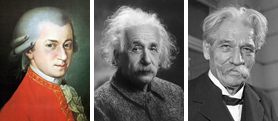
We have occasionally written about human cloning here on Futurisms — for example, five years ago we had a back–and–forth with Kyle Munkittrick about cloning — and we return to the subject today, with an excerpt from the latest issue of The New Atlantis. The entirety of that new issue is dedicated to a report called The Threat of Human Cloning: Ethics, Recent Developments, and the Case for Action. The report, written by a distinguished body of academics and policy experts, makes the case against all forms of human cloning — both for the purpose of creating children and for the purpose of biomedical research. Below is one excerpt from the report, a section exploring the possibility of using cloning to create “enhanced” offspring. (I have removed the citations from this excerpt, but you can find them and read this section in context here.)
Cloning for “human enhancement.” Much of the enthusiasm for and anxiety about human cloning over the years has been concerned with the use of cloning as a genetic enhancement technology. Scientists, and especially science-fiction writers, have imagined ways of using cloning to replicate “persons of attested ability” as a way to “raise the possibility of human achievement dramatically,” in the words of J.B.S. Haldane. As molecular biologist Robert L. Sinsheimer argued in 1972, “cloning would in principle permit the preservation and perpetuation of the finest genotypes that arise in our species.” Candidates for this distinction often include Mozart and Einstein, though the legacy of eugenics in the twentieth century has left many authors with an awareness that those who would use these technologies may be more interested in replicating men like Hitler. (While in most cases, the idea of cloning a dictator like Hitler is invoked as a criticism of eugenic schemes, some writers have actually advocated the selective eugenic propagation of tyrants — for instance, the American geneticist Hermann J. Muller who, in a 1936 letter to Stalin advocating the eugenic use of artificial insemination, named Lenin as an example of a source of genetic material whose outstanding worth “virtually all would gladly recognize.”)
Today, eugenics has a deservedly negative reputation, and the idea of using a biotechnology like cloning to replicate individuals of exceptional merit is prima facie ethically suspect. However, advocates of eugenic enhancement have never entirely disappeared, and their influence in bioethics is arguably not waning, but waxing. In recent years academic bioethicists like John Harris and Julian Savulescu have been attempting to rehabilitate the case for eugenic enhancements on utilitarian grounds. For these new eugenicists, cloning-to-produce-children represents “power and opportunity over our destiny.”

This new eugenics needs to be confronted and refuted directly, since insisting on the self-evident evil of eugenics by pointing to historical atrocities committed in its name may become increasingly unpersuasive as memories of those atrocities dim with time, and as new technologies like cloning and genetic engineering make eugenic schemes all the more attractive. Furthermore, as the philosopher Hans Jonas noted in a critique of cloning, the argument in favor of cloning excellent individuals, “though naïve, is not frivolous in that it enlists our reverence for greatness and pays tribute to it by wishing that more Mozarts, Einsteins, and Schweitzers might adorn the human race.”
In an important sense, cloning is not an enhancement, since it replicates, rather than improves on, an existing genome. However, as Jonas’s remark about the human race indicates, the cloning of exceptional genotypes could be an enhancement at the population level. And from the point of view of parents who want children who can checkmate like Kasparov, belt like Aretha, dunk like Dr. J, or bend it like Beckham, cloning could represent a way to have offspring with the exceptional abilities of these individuals.
Arguably, cloning is a less powerful form of genetic engineering than other techniques that introduce precise modifications to the genome. After all, cloning only replicates an existing genome; it doesn’t involve picking and choosing specific traits. This weakness may also, however, make cloning more appealing than other forms of genetic engineering, especially when we consider the genetic complexity of many desirable traits. For example, some parents might seek to enhance the intelligence of their children, and evidence from twin studies and other studies of heredity seems to indicate that substantial amounts of the variation in intelligence between individuals can be attributed to genetics. But any given gene seems to have only a tiny effect on intelligence; one recent study looking at several genes associated with intelligence found that they each accounted for only about 0.3 points of IQ. With such minor effects, it would be difficult to justify the risks and expense of intervening to modify particular genes to improve a trait like intelligence.
Cloning, on the other hand, would not require certain and specific knowledge about particular genes, it would only require identifying an exceptionally intelligent individual and replicating his or her genome. Of course the cloned individual’s exceptional intelligence may be due to largely non-genetic factors, and so for a trait like intelligence there will never be certainty about whether the cloned offspring will match their genetic progenitor. But for people seeking to give their child the best chance at having exceptional intelligence, cloning may at least seem to offer more control and predictability than gene modification, and cloning is more consistent with our limited understanding of the science of genetics. Genetic modification involves daunting scientific and technical challenges; it offers the potential of only marginal improvements in complex traits, and it holds out the risk of unpredictable side effects and consequences.
Of course, it is possible that cloning could be used in conjunction with genetic modification, by allowing scientists to perform extensive genetic manipulations of somatic cells before transferring them to oocytes. In fact, genetic modification and cloning are already used together in agriculture and some biomedical research: for larger animals like pigs and cattle, cloning remains the main technique for producing genetically engineered offspring….
Using cloning as an enhancement technology requires picking some exceptional person to clone. This necessarily separates social and genetic parenthood: children would be brought into the world not by sexual pairing, or as an expression of marital love, or by parents seeking to continue and join their lineages, but by individuals concerned with using the most efficient technical methods to obtain a child with specific biological properties. Considerations about the kinds of properties the child will have would dominate the circumstances of a cloned child’s “conception,” even more than they already do when some prospective parents seek out the highest-quality egg or sperm donors, with all the troubling consequences such commodified reproduction has for both buyers and sellers of these genetic materials and the children that result. With cloning-to-produce-children for the sake of eugenic enhancement, parents (that is, the individuals who choose to commission the production of a cloned child) will need to be concerned not with their genetic relationship to their children, but only with the child’s genetic and biological properties.
Normally, the idea of cloning as an enhancement is to create children with better properties in which the improvement resides in an individual and his or her traits, but some thinkers have proposed that cloning could be used to offer an enhancement of social relationships. This is the very reason given in the novel Brave New World: the fictional society’s cloning-like technology “is one of the major instruments of social stability! … Standard men and women; in uniform batches,” allowing for excellence and social order. And as the geneticist Joshua Lederberg argued in 1966, some of the advantages of cloning could flow from the fact of the clones’ being identical, independent of the particular genes they have. Genetically identical clones, like twins, might have an easier time communicating and cooperating, Lederberg wrote, on the assumption “that genetic identity confers neurological similarity, and that this eases communication” and cooperation. Family relationships would even improve, by easing “the discourse between generations,” as when “an older clonont would teach his infant copy.” Lederberg’s imaginings will rightly strike today’s readers as naïve and unsettling. Such a fixation on maintaining sameness within the family would undermine the openness to new beginnings that the arrival of each generation represents.
Before we embark on asexual reproduction in order deliberately to select our offspring’s genes, we would do well to remember that sexual reproduction has been the way of our ancestors for over a billion years, and has been essential for the flourishing of the diverse forms of multicellular life on earth. We, who have known the sequence of the human genome for a mere fifteen years — not even the span of a single human generation — and who still do not have so much as a precise idea of how many genes are contained in our DNA, should have some humility when contemplating such a radical departure.
